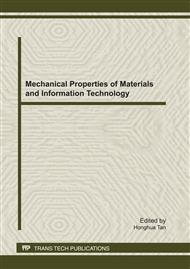[1]
K. Lirdprapamongkol, et al., Juice of eclipta prostrata inhibits cell migration in vitro and exhibits anti-angiogenic activity in vivo, In Vivo, vol. 22, pp.363-8, May-Jun (2008).
Google Scholar
[2]
R. Domenico, Pharmacology of nitric oxide: molecular mechanisms and therapeutic strategies, Curr Pharm Des, vol. 10, pp.1667-76, (2004).
Google Scholar
[3]
C. G. da Silva, et al., Mechanism of purinergic activation of endothelial nitric oxide synthase in endothelial cells, Circulation, vol. 119, pp.871-9, Feb 17 (2009).
DOI: 10.1161/circulationaha.108.764571
Google Scholar
[4]
G. S. Sim, et al., Structure activity relationship of antioxidative property of flavonoids and inhibitory effect on matrix metalloproteinase activity in UVA-irradiated human dermal fibroblast, Arch Pharm Res, vol. 30, pp.290-8, Mar (2007).
DOI: 10.1007/bf02977608
Google Scholar
[5]
O. Kagami, et al., Protein engineering on biphenyl dioxygenase for conferring activity to convert 7-hydroxyflavone and 5, 7-dihydroxyflavone (chrysin), J Biosci Bioeng, vol. 106, pp.121-7, Aug (2008).
DOI: 10.1263/jbb.106.121
Google Scholar
[6]
T. Zhang, et al., Chrysin and its phosphate ester inhibit cell proliferation and induce apoptosis in Hela cells, Bioorg Med Chem, vol. 12, pp.6097-105, Dec 1 (2004).
DOI: 10.1016/j.bmc.2004.09.013
Google Scholar
[7]
E. Ognibene, et al., Behavioral effects of 6-bromoflavanone and 5-methoxy-6, 8-dibromoflavanone as anxiolytic compounds, Prog Neuropsychopharmacol Biol Psychiatry, vol. 32, pp.128-34, Jan 1 (2008).
DOI: 10.1016/j.pnpbp.2007.07.023
Google Scholar
[8]
E. K. Shin, et al., Chrysin, a natural flavone, improves murine inflammatory bowel diseases, Biochem Biophys Res Commun, vol. 381, pp.502-7, Apr 17 (2009).
DOI: 10.1016/j.bbrc.2009.02.071
Google Scholar
[9]
R. Lopez-Posadas, et al., Effect of flavonoids on rat splenocytes, a structure-activity relationship study, Biochem Pharmacol, vol. 76, pp.495-506, Aug 15 (2008).
Google Scholar
[10]
S. Matsumoto, et al., Solution structure of the variable-type domain of the receptor for advanced glycation end products: new insight into AGE-RAGE interaction, Biochemistry, vol. 47, pp.12299-311, Nov 25 (2008).
DOI: 10.1021/bi800910v
Google Scholar
[11]
T. Lapidot, et al., Antioxidant and prooxidant effects of phenolics on pancreatic beta-cells in vitro, J Agric Food Chem, vol. 50, pp.7220-5, Dec 4 (2002).
DOI: 10.1021/jf020615a
Google Scholar
[12]
S. M. Peng, et al., Synthesis and promotion angiogenesis effect of chrysin derivatives coupled to NO donors, Bioorg Med Chem Lett, Jan 10 (2009).
Google Scholar
[13]
D. Liu, et al., Dehydroepiandrosterone stimulates endothelial proliferation and angiogenesis through extracellular signal-regulated kinase 1/2-mediated mechanisms, Endocrinology, vol. 149, pp.889-98, Mar (2008).
DOI: 10.1210/en.2007-1125
Google Scholar
[14]
P. Dufourcq, et al., FrzA, a secreted frizzled related protein, induced angiogenic response, Circulation, vol. 106, pp.3097-103, Dec 10 (2002).
DOI: 10.1161/01.cir.0000039342.85015.5c
Google Scholar
[15]
X. Q. Zou, et al., Synthesis, characterization and vasculoprotective effects of nitric oxide-donating derivatives of chrysin, Bioorg Med Chem, vol. 18, pp.3020-5, May 1.
Google Scholar
[16]
J. Xiao, et al., Involvement of dimethylarginine dimethylaminohydrolase-2 in visfatin-enhanced angiogenic function of endothelial cells, Diabetes Metab Res Rev, vol. 25, pp.242-9, Mar (2009).
DOI: 10.1002/dmrr.939
Google Scholar
[17]
O. Tarasenko, et al., Killing of Bacillus spores is mediated by nitric oxide and nitric oxide synthase during glycoconjugate-enhanced phagocytosis, Glycoconj J, vol. 27, pp.13-25, Jan.
DOI: 10.1007/s10719-009-9248-7
Google Scholar
[18]
D. W. Leung, et al., Vascular endothelial growth factor is a secreted angiogenic mitogen, Science, vol. 246, pp.1306-9, Dec 8 (1989).
DOI: 10.1126/science.2479986
Google Scholar
[19]
K. A. Thomas, Vascular endothelial growth factor, a potent and selective angiogenic agent, J Biol Chem, vol. 271, pp.603-6, Jan 12 (1996).
DOI: 10.1074/jbc.271.2.603
Google Scholar


